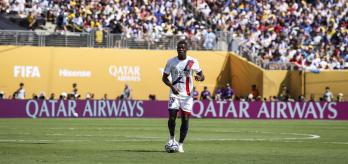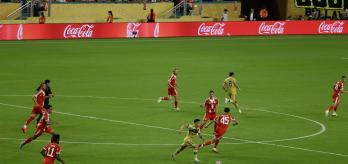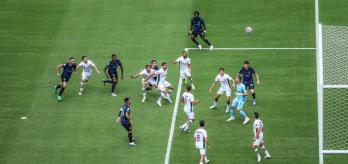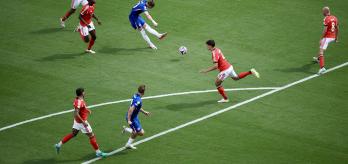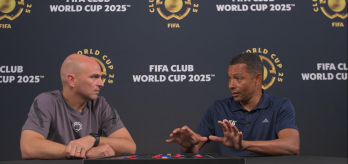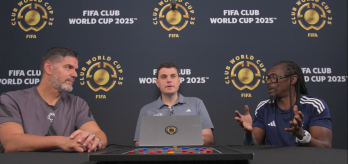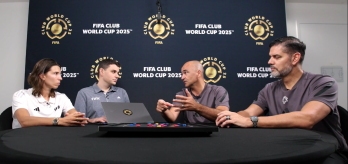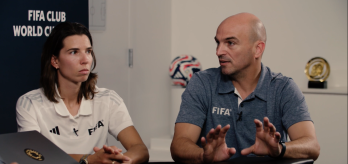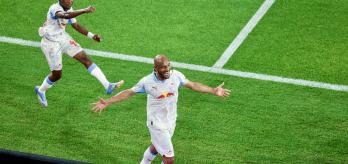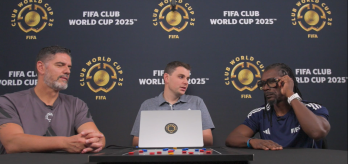Making saves from close range and in 1v1 situations is vital, and many factors affect the decision-making process that goalkeepers go through in these circumstances. For FIFA’s Technical Study Group Lead, Pascal Zuberbühler (Zubi), the intelligence and techniques of goalkeepers in these key moments of the game are improving and having a genuine impact on the outcomes of situations where attacking players might be expected to score.
“The X-block is a relatively modern technique in goalkeeping, but during the FIFA Club World Cup 2025™, we are observing that goalkeepers are making better decisions in these situations, using the technique more, and appear to be having more success at making saves or forcing the attacking player to misjudge hitting the target, because they are so imposing when using the X-block. It’s fascinating to see,” he explained.
After the quarter-final stage of this tournament, our Football Performance Insights Team noted that goalkeepers had performed 78 X-blocks compared to 39 at the same stage of FIFA World Cup Qatar 2022™, which is, notably, a 100% increase. In this article, Zuberbühler analyses the technique in detail, particularly exploring the difference between applying the X-block when the attacking player is about to strike at goal within a six-metre range and when they are beyond that range.
However, in both situations, it is important for the goalkeeper to:
-
Understand where their defenders are in relation to the situation and if they are active
-
Recognise when they are in a 1v1 situation
-
Get into the set position before the ball is struck at goal
The set position: When the striker of the ball is +6m away
When the attempt at goal comes from a range further than six metres from the goalkeeper, the set position (arms deep, hands low, upper body upright, and both feet planted) is adopted before the attacking player makes the strike at goal.
Zuberbühler uses the two clips below to explain the nuances of being in this set position when the attempt at goal is more than six metres from the goalkeeper.
“In clip 1, we see Real Madrid goalkeeper Thibaut Courtois moving closer to his goal as Adam Daghim (28) of FC Salzburg is advancing towards the penalty area. His defenders are still active, so he can focus on defending the goal. When Daghim gets around the defender, he takes his first touch away from goal, which means Courtois does not need to engage on a 1v1 basis, but as he goes on the outside and gets into a position to strike at goal, the goalkeeper gets set with his arms low. This means he can react explosively to make strong contact with the ball with his right hand. He reads the situation brilliantly.”
In clip 2, Porto goalkeeper Claudio Ramos makes a save against FC Inter Miami with his left leg from the set position.
“This situation is different. Inter Miami midfielder Benjamin Cremaschi (30) is travelling on the outside, away from the goal, and Ramos has defenders who can intervene. So, it’s clear he defends the goal because his defenders are still active. Even when Cremaschi takes two touches and Ramos adjusts his position, the defenders are still active. Ramos is upright, allowing his defender to do his job. But as soon as Cremaschi tees up to strike at goal from 10 metres away, Ramos gets set. His hips are pushed back, his hands are higher, and his weight is coming more through his heels. This means he can react better to save low with his outstretched left leg. His hips are leaning backwards as he makes the decisive contact.”
The X-block: When the striker of the ball is within 1-6m range
When the attacking player is striking at goal from within 1-6 metres of the goalkeeper, the technique is totally different — the main difference being that the goalkeeper must initiate an X-block technique before the attacking player strikes the ball at goal to have any chance of making contact with the ball.
Zuberbühler uses the clips below to highlight the difference.
“In clip 3, SE Palmeiras goalkeeper Weverton (21) makes an outstanding save with his left hand from close range. His defenders are out of the game, so it’s a clear 1v1. Until the attacker has the ball under control, Weverton can come forward and close the distance to make himself as big as possible and close the angle. As he tees up to strike at goal, Weverton is already teeing up the X-block. His legs are out, upper body is upright, arms are open wide, and fingers are outstretched to ensure every part of his body is available to make the save.”
Clip 4 shows SL Benfica goalkeeper Anatoliy Trubin (1) making a crucial save against FC Bayern München.
“Before the through ball is played, Trubin defends his goal because the striker can shoot from further out. As Leroy Sané breaks through, it is a clear 1v1, but because his first touch of the ball is not under complete control and Trubin knows Sané will prefer to strike with his left foot, he can make the first steps towards the attacker and close the angle. As soon as he starts to kick the ball, Trubin is ready and entering the X-block. This is a very close distance and a high-speed situation, but Trubin makes brilliant decisions and judges it perfectly before saving with his right leg.”
Going beyond
A key feature of using the X-block from close range is that the goalkeeper must commit to the technique before the attacking player strikes at goal. This requires the goalkeeper to commit fully, knowing that if the attacker takes an additional touch away to either side, the goalkeeper is very limited in what they can do. However, the mentality of the goalkeeper can make a very big difference in a situation that might be considered unassailable.
Zuberbühler has identified an outstanding example of how a goalkeeper can use every sinew of their body in an X-block situation to resolve it by simply refusing to give up. This type of goalkeeping comes from the heart, soul and mindset of the goalkeeper.
The clip selected shows Al Hilal goalkeeper Yassine Bounou (37) in a relentless goalkeeping moment against Savinho (26), which leads to a decisive save in their 4-3 victory over Manchester City FC in the Round of 16. But first, in the screenshots below, Zubi breaks down the techniques and decisions in detail, showing Bounou’s incredible observation skills and how he commits everything he has to keeping the ball out.
Expert technical advice
For Zuberbühler, the decision-making and timing involved in performing these X-blocks do not come by chance, but from dedicated training time and specific work with the goalkeeper coach over a long period of time.
“To develop the athleticism, technique and speed of thought required for these crucial match situations, goalkeepers must train them regularly. To build the components needed, the training must start at youth level and in academies because these situations demand a lot of courage and bravery as they need to use their whole body and be prepared.”







